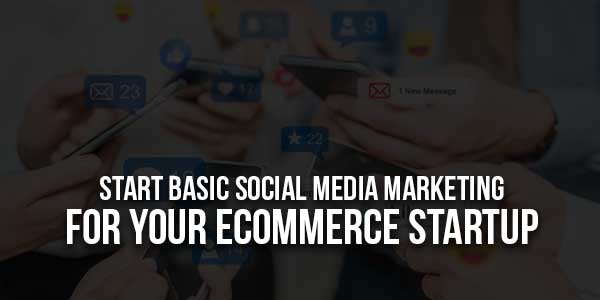
Social media has become an indispensable tool for businesses, especially eCommerce startups looking to establish their presence and reach a wider audience. With the right strategy, social media marketing can drive traffic, increase brand awareness, and boost sales. In this guide, we’ll explore the steps to start basic social media marketing for your eCommerce startup.
Table of Contents
1.) Introduction:
Starting an eCommerce business is an exciting venture, but with millions of online stores competing for attention, how do you stand out? Social media marketing offers a powerful way to connect with potential customers, build brand loyalty, and ultimately increase sales. Whether you’re just starting or looking to enhance your current strategy, this guide will walk you through the basics of social media marketing for eCommerce startups.
2.) Understanding Social Media Marketing:
What is Social Media Marketing?
Social media marketing involves using social media platforms to promote your products or services, engage with your audience, and build your brand’s reputation. It encompasses a variety of activities, including content creation, community management, and paid advertising.
Benefits of Social Media Marketing for eCommerce Startups:
Social media marketing offers numerous advantages for eCommerce startups:
- Increased Brand Awareness: Social media platforms provide an opportunity to reach a large audience, increasing your brand’s visibility and recognition.
- Cost-Effective Advertising: Compared to traditional advertising methods, social media marketing is often more affordable and offers a higher return on investment.
- Improved Customer Engagement: Social media allows you to interact directly with your customers, fostering relationships and building trust.
- Enhanced Customer Insights: Analyzing social media interactions and data provides valuable insights into customer behaviour and preferences.
3.) Setting Clear Goals:
Defining Your Objectives:
Before diving into social media marketing, it’s essential to define your objectives. What do you hope to achieve? Common goals for eCommerce startups include:
- Increasing Website Traffic: Driving more visitors to your online store can lead to increased sales and brand recognition.
- Boosting Brand Awareness: Building your brand’s presence on social media helps establish credibility and attract new customers.
- Generating Leads: Collecting contact information from potential customers allows you to nurture relationships and drive conversions.
- Improving Customer Engagement: Engaging with your audience builds trust and loyalty, leading to repeat purchases.
Aligning Goals with Business Strategy:
Ensure your social media marketing goals align with your overall business strategy. For example, if your primary business objective is to increase sales, your social media goals should focus on driving traffic and conversions.
4.) Identifying Your Target Audience:
Creating Buyer Personas:
Understanding your target audience is crucial for effective social media marketing. Start by creating buyer personas—fictional representations of your ideal customers based on demographic data, purchasing behaviour, and interests.
Understanding Customer Needs and Preferences:
Conduct market research to understand your customers’ needs, preferences, and pain points. This information will guide your content creation and help you tailor your messaging to resonate with your audience.
5.) Choosing the Right Platforms:
Analyzing Platform Demographics:
Different social media platforms attract different demographics. Analyze the demographics of each platform to determine which ones align with your target audience. For example:
- Facebook: Popular among a wide range of age groups, particularly those aged 25-54.
- Instagram: Appeals to a younger audience, with a strong presence among users aged 18-34.
- Twitter: Attracts users interested in real-time news and updates, with a significant portion aged 18-49.
- Pinterest: Known for its strong female user base, with interests in DIY, fashion, and home decor.
- LinkedIn: Ideal for B2B marketing and reaching professionals, with users primarily aged 25-54.
Selecting Platforms that Align with Your Brand:
Choose platforms that align with your brand’s identity and goals. It’s better to focus on a few platforms where you can effectively engage with your audience than to spread yourself too thin across multiple platforms.

6.) Crafting a Content Strategy:
Types of Content to Create:
Content is the backbone of social media marketing. Consider creating a mix of content types to keep your audience engaged, such as:
- Product Photos and Videos: Showcase your products in action, highlighting their features and benefits.
- Educational Content: Share tips, tutorials, and how-to guides related to your products or industry.
- User-Generated Content: Encourage customers to share photos and reviews of your products, building social proof.
- Behind-the-Scenes Content: Give your audience a glimpse into your business operations and team.
- Promotional Content: Highlight sales, discounts, and special offers to drive conversions.
Establishing a Content Calendar:
A content calendar helps you plan and organize your social media posts in advance. It ensures consistent posting, aligns with your marketing goals, and allows you to capitalize on seasonal trends and events.
7.) Building and Growing Your Audience:
Organic Growth Strategies:
Building an audience organically takes time but can lead to a loyal customer base. Consider these strategies:
- Optimize Your Profiles: Ensure your social media profiles are complete and reflect your brand identity. Use consistent branding elements, such as logos and colour schemes.
- Engage with Your Audience: Respond to comments and messages promptly, and engage with your audience through likes and shares.
- Leverage Hashtags: Use relevant hashtags to increase the discoverability of your posts and reach a wider audience.
- Participate in Communities: Join and actively participate in social media groups and communities related to your niche.
Leveraging Influencer Collaborations:
Partnering with influencers can help you reach a broader audience and build credibility. Identify influencers who align with your brand values and have a genuine connection with their followers.
“Influencer marketing is not about quick wins; it’s about building lasting relationships and creating authentic content that resonates with the audience.” – Expert in Digital Marketing
8.) Engaging with Your Audience:
Responding to Comments and Messages:
Engagement is a two-way street. Make it a priority to respond to comments and messages from your audience. Acknowledge positive feedback and address any concerns or questions promptly and professionally.
Creating Interactive Content:
Interactive content encourages audience participation and can increase engagement. Consider using:
- Polls and Surveys: Gather feedback from your audience and involve them in decision-making processes.
- Quizzes: Create fun and informative quizzes related to your products or industry.
- Live Videos: Host live events, Q&A sessions, or product demonstrations to engage with your audience in real time.
9.) Utilizing Paid Advertising:
Setting a Budget for Ads:
Paid advertising can accelerate your growth and reach. Set a budget that aligns with your marketing goals and allows for testing and optimization. Start with a modest budget and gradually increase it as you see results.
Designing Effective Ad Campaigns:
When creating ad campaigns, focus on the following elements:
- Targeting: Use audience targeting options to reach specific demographics, interests, and behaviours.
- Ad Creative: Design visually appealing ads with compelling headlines and clear calls to action.
- A/B Testing: Test different ad variations to identify what works best and optimize your campaigns accordingly.
10.) Analyzing and Measuring Success:
Key Performance Indicators (KPIs):
Identify and track key performance indicators (KPIs) to measure the success of your social media marketing efforts. Common KPIs include:
- Reach: The number of people who see your content.
- Engagement: The number of likes, comments, shares, and interactions with your content.
- Conversion Rate: The percentage of users who take a desired action, such as making a purchase.
- Return on Investment (ROI): The revenue generated from your social media marketing efforts compared to the cost.
Tools for Tracking and Analytics:
Use tools like Google Analytics, Facebook Insights, and social media management platforms to track and analyze your performance. These tools provide valuable data on audience demographics, content performance, and conversion metrics.
Conclusion:
Social media marketing is a powerful tool for eCommerce startups looking to establish their brand and connect with customers. By setting clear goals, understanding your audience, choosing the right platforms, and crafting a compelling content strategy, you can effectively harness the potential of social media to drive growth and success for your business. Remember, consistency and authenticity are key to building lasting relationships with your audience and achieving your marketing objectives.
With dedication and a strategic approach, your eCommerce startup can thrive in the competitive world of social media marketing. Keep learning, adapting, and refining your strategy to stay ahead of the curve and continue delivering value to your customers.

















Be the first to write a comment.